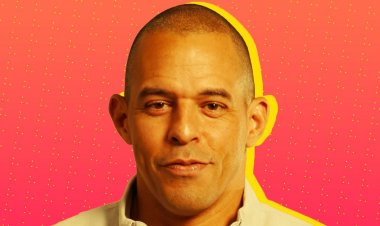The creators of 3 Body Problem want to have ‘a back and forth’ with the book
3 Body Problem executive producers Alexander Woo, David Benioff, and D.B. Weiss. | Image: Ed Miller / Netflix Between its expanded, more ethnically diverse cast and its more advanced take on virtual reality gaming, Netflix’s new 3 Body Problem series unfolds in a very different way than the book it’s adapting. Cixin Liu’s novel is so dense and internal dialogue-driven that it was widely thought to be unadaptable for the screen. Changes are almost always necessary when translating stories as complex as 3 Body Problem’s across mediums (and in this case, languages as well). But when I recently spoke with executive producers David Benioff, D.B. Weiss, and Alexander Woo ahead of 3 Body Problem’s premiere, they said that, while they always knew their story needed to be different, as they began reimagining narrative beats, they realized that “there was going to have to be a back and forth” between the show and Liu’s book. In Liu’s book, a very small number of brilliant Chinese physicists are left to their own devices to figure out why scientists around the world are killing themselves and what’s causing the world’s particle accelerators to malfunction in inexplicable ways. Though the book’s characters start off working in isolation, the arrival of a mysterious VR game gradually pulls them into one another’s orbits. And as they grow closer, the terrifying truth of what the entire world is up against becomes all too clear. Netflix’s show tells a mostly similar story, but its comparatively larger cast of lead characters come together far faster than their book analogues — so much so that you don’t get to spend all that much time watching them think problems through on their own. Liu used characters’ interior thoughts to help readers understand the book’s more abstract ideas about the technology and how societies could be differently organized, with more focus on the fates of future generations. Internal dialogues don’t always make for the most interesting viewing experiences, and one of Benioff, Weiss, and Woo’s biggest challenges as they begin breaking scripts on 3 Body Problem was figuring out how best to go about drawing on those scenes from the book in ways that would make for good television. In many cases, the answer wound up being to just do things completely differently. “Some things work great on the page because I’m inside this guy’s head, and I know exactly what he’s thinking,” Benioff said. “But then when I pull that scene off the page, and put it on the screen, I don’t have any way to understand what he’s thinking. I need to find some other way into his mind and into his motivations other than just them being delivered in writing on the page.” Liu used characters like Wang Miao — a professor haunted by visions of a glowing countdown that only he can see — to explore the feelings of fear and confusion that would overtake people when faced with a threat like the one at the center of his novel. Netflix’s 3 Body Problem reworks Wang into five different characters whose shared friendships are a big part of what makes them start problem-solving together basically from the first episode. Interpersonal relationships were also part of Liu’s story, albeit to a much smaller extent. But Woo explained that the decision to split Wang’s character up was also motivated by a desire to give viewers an emotional foothold to grab onto. “In the case of these books, the lead characters often don’t intersect,” Woo pointed out. “They have their own independent storylines, and sometimes they just disappear and never come back again. But from all of our experience adapting books to television, the one thing that we feel is at the heart of any great series that gets under your skin is the characters. That’s what makes you want to watch the next episode and make sure you count the days till the next season.” Image: Netflix Jess Hong as Jin Cheng on the set of 3 Body Problem. Woo reasoned that it was important to get all of the players on the chessboard “because that’s what’s going to propel us throughout” the series as it gets increasingly sci-fi and fantastical the way 3 Body Problem does. “And when all those crazy things happen, you’re emotionally engaged through them,” Woo said. “So rather than just watching a ton of amazing effects — of which there are many — you’re also understanding it from an emotional standpoint as well.” Because Netflix’s 3 Body Problem spends so much time fleshing its characters and their dynamics out, it feels almost like the show’s real story — one that reaches much further into the future and beyond planet Earth — is only just beginning by the first season’s end. Netflix has yet to announce whether it plans to renew 3 Body Problem for more seasons that would delve deeper into Liu’s Remembrance of Earth’s Past trilogy. But Benioff says he and his collaborators are ready if that does happen — “[we] want to spend the next five or six years of our liv
/cdn.vox-cdn.com/uploads/chorus_asset/file/25354175/3BP_101_Unit_08817R.jpg_3BP_101_Unit_08817R.jpg)

Between its expanded, more ethnically diverse cast and its more advanced take on virtual reality gaming, Netflix’s new 3 Body Problem series unfolds in a very different way than the book it’s adapting. Cixin Liu’s novel is so dense and internal dialogue-driven that it was widely thought to be unadaptable for the screen. Changes are almost always necessary when translating stories as complex as 3 Body Problem’s across mediums (and in this case, languages as well). But when I recently spoke with executive producers David Benioff, D.B. Weiss, and Alexander Woo ahead of 3 Body Problem’s premiere, they said that, while they always knew their story needed to be different, as they began reimagining narrative beats, they realized that “there was going to have to be a back and forth” between the show and Liu’s book.
In Liu’s book, a very small number of brilliant Chinese physicists are left to their own devices to figure out why scientists around the world are killing themselves and what’s causing the world’s particle accelerators to malfunction in inexplicable ways. Though the book’s characters start off working in isolation, the arrival of a mysterious VR game gradually pulls them into one another’s orbits. And as they grow closer, the terrifying truth of what the entire world is up against becomes all too clear.
Netflix’s show tells a mostly similar story, but its comparatively larger cast of lead characters come together far faster than their book analogues — so much so that you don’t get to spend all that much time watching them think problems through on their own. Liu used characters’ interior thoughts to help readers understand the book’s more abstract ideas about the technology and how societies could be differently organized, with more focus on the fates of future generations.
Internal dialogues don’t always make for the most interesting viewing experiences, and one of Benioff, Weiss, and Woo’s biggest challenges as they begin breaking scripts on 3 Body Problem was figuring out how best to go about drawing on those scenes from the book in ways that would make for good television. In many cases, the answer wound up being to just do things completely differently.
“Some things work great on the page because I’m inside this guy’s head, and I know exactly what he’s thinking,” Benioff said. “But then when I pull that scene off the page, and put it on the screen, I don’t have any way to understand what he’s thinking. I need to find some other way into his mind and into his motivations other than just them being delivered in writing on the page.”
Liu used characters like Wang Miao — a professor haunted by visions of a glowing countdown that only he can see — to explore the feelings of fear and confusion that would overtake people when faced with a threat like the one at the center of his novel. Netflix’s 3 Body Problem reworks Wang into five different characters whose shared friendships are a big part of what makes them start problem-solving together basically from the first episode. Interpersonal relationships were also part of Liu’s story, albeit to a much smaller extent. But Woo explained that the decision to split Wang’s character up was also motivated by a desire to give viewers an emotional foothold to grab onto.
“In the case of these books, the lead characters often don’t intersect,” Woo pointed out. “They have their own independent storylines, and sometimes they just disappear and never come back again. But from all of our experience adapting books to television, the one thing that we feel is at the heart of any great series that gets under your skin is the characters. That’s what makes you want to watch the next episode and make sure you count the days till the next season.”
/cdn.vox-cdn.com/uploads/chorus_asset/file/25354926/3BP_101_Unit_05125R.jpg_3BP_101_Unit_05125R.jpg) Image: Netflix
Image: Netflix
Woo reasoned that it was important to get all of the players on the chessboard “because that’s what’s going to propel us throughout” the series as it gets increasingly sci-fi and fantastical the way 3 Body Problem does.
“And when all those crazy things happen, you’re emotionally engaged through them,” Woo said. “So rather than just watching a ton of amazing effects — of which there are many — you’re also understanding it from an emotional standpoint as well.”
Because Netflix’s 3 Body Problem spends so much time fleshing its characters and their dynamics out, it feels almost like the show’s real story — one that reaches much further into the future and beyond planet Earth — is only just beginning by the first season’s end. Netflix has yet to announce whether it plans to renew 3 Body Problem for more seasons that would delve deeper into Liu’s Remembrance of Earth’s Past trilogy. But Benioff says he and his collaborators are ready if that does happen — “[we] want to spend the next five or six years of our lives working on bringing them to the screen. That’s a pretty strong feeling.”











/cdn.vox-cdn.com/uploads/chorus_asset/file/25115065/DCD_Avishai_Abrahami.jpg)

/cdn.vox-cdn.com/uploads/chorus_asset/file/23951566/VRG_Illo_STK184_L_Normand_PhilSpencer_Neutral.jpg)
/cdn.vox-cdn.com/uploads/chorus_asset/file/25254957/VRG_DCD_Brian_Schatz.jpg)
/cdn.vox-cdn.com/uploads/chorus_asset/file/25372328/DCD_Matthew_Prince.jpg)


/cdn.vox-cdn.com/uploads/chorus_asset/file/25137937/236942_Nic_Cage_Interview2_CVirginia.jpg)



/cdn.vox-cdn.com/uploads/chorus_asset/file/25157482/236883_Epic_Vs_Google_10_CVirginia.jpg)




